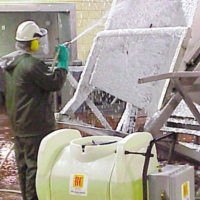Given all the potential causal factors of foodborne diseases—factors related to temperature abuse, poor personal hygiene or cross-contamination—the sanitarian’s best effort in the field can only focus on a moment in time. In truth, each observation has relatively equal weighting in terms of time spent on that observation. During an inspection, we essentially make a snapshot of conditions as we see them and take comfort in the fact that the measure of compliance is composed of an aggregate of factors: the more violations or the lower the inspection score, the greater the risk of a foodborne misadventure.
The deli slicer may be the one piece of powered equipment that makes us break with this tradition. Meat slicers are among the most difficult items to clean and are probably the most microbiologically hazardous pieces of equipment used in retail foodservice establishments. The time spent on inspecting deli slicers and ensuring proper sanitation and maintenance by the user is time well spent in the prevention of vehicle-mediated foodborne illness.
Well-publicized Salmonella outbreaks in Georgia and Washington, in addition to a spate of deadly Listeria monocytogenes outbreaks linked to meat-slicer maintenance and sanitation, are prompting a fresh look at this retail food establishment equipment staple. Unlike any other powered equipment used in retail foodservice, more often than not, the meat slicer sees random, intermittent use throughout the working day under ambient temperature conditions, while mixers, food processors, grinders, can openers and the like are primarily used during food preparation and are generally cleaned after use. Even such powered foodservice equipment as soft-serve ice cream machines have a finite operating time and are cleaned on a regular schedule that does not interfere with the normal business day. Although their time in operation is somewhat longer than that of other machines, the advantage of the soft-serve machines is that their food-contact parts—including the barrel, the dasher and the dispenser—are kept under constant refrigeration.
There is little predictability to deli slicer downtime in a traditional delicatessen setting. For this reason, I would like to expand on this topic and ultimately urge a bit more vigilance, with a large dose of common sense for both the operator and the regulator.
Equipment Standards
Reducing the risk of cross-contamination from deli slicers is a shared responsibility. It begins with the manufacturer of the equipment. The companies that manufacture meat slicers have the responsibility to build their meat slicers in accordance with the requirements set forth in acceptable standards and policies, which in this case means NSF/ANSI Standard 8: Commercial Powered Food Preparation Equipment. The Standard details the minimum requirements for the materials, design and construction of new power-operated commercial food preparation equipment, including meat slicers, to ensure food protection and sanitation. As of this writing, Standard 8 is undergoing revisions in design and fabrication of meat slicers in response to field surveys that will further enhance slicer sanitation and prevention of cross-contamination. However, the Standard neither establishes requirements for cleaning procedures nor provides information on cleaning frequency. This is left for the manufacturers to develop, specifically for their units. Cleaning frequency is determined by the nature and conditions of use and is rightfully in the purview of the regulator. Good applied science and solid epidemiological evidence provides the rationale.
The operators of meat slicers have the responsibility to use the equipment properly by diligently seeing to their sanitation, maintenance and operator safety (the latter being a topic unto itself). This would include adhering to the manufacturer’s instruction manual recommendations on cleaning (yes, they know best how to do it) and ensuring that the unit is in good repair at all times, replacing cracked and worn parts and frequently inspecting the slicer’s seals.
With regard to the seals: many slicer manufacturers use sealants at seams and in the spaces between assembled parts such as handles. Under normal conditions, the proper application of sealants assures cleanability of the slicer and prevents food and dirt from accumulating in small spaces where microbes can flourish. With normal repeated use and multiple cleanings—particularly when slightly corrosive chemicals including sanitizers are used—cracks can appear in the sealants, or the seals can shrink or spall from simple aging of the equipment. When this happens, food materials and possibly pathogenic microbes can enter the minute spaces in or behind the cracked seal and become a vehicle for cross-contamination. If any compromised seals are identified, the slicer should be removed from service until repairs and maintenance are completed.
To ensure longevity of seal integrity, the operator should use only cleaning and sanitizing chemicals that are recommended by the equipment manufacturer. Compatibility is the key. The sanitizers should meet the criteria specified in the Food Code (chapter §7-204.1) and should be used in accordance with the EPA-registered manufacturer’s label use instructions.
The user has a further responsibility to inspect the slicer when it is assembled and ready for use. Needless to say, it should be fully intact. The Washington State Department of Health Food Safety Program identified numerous problems on meat slicers that were inadequately maintained. They published these findings in the Winter 2008 edition of their Food Safety Newsletter. In addition to degraded and missing seals, the sanitarians found deteriorated, broken and missing parts of both food-contact and non-contact surfaces, particularly handles and plastic components, which were either cracked or broken, along with missing screws. All in all, over half the slicers with both metal and plastic components had cracked and broken parts. When conditions such as these are identified, any and all repairs should be promptly completed by the manufacturer’s authorized service representatives.
The Food Code (chapter §4-602.11, Equipment Food-Contact Surfaces and Utensils.) is quite specific and detailed regarding cleaning frequency and methodology. It states that equipment such as meat slicers must be taken apart and cleaned every four hours. Inspections revealed that very few establishments were cleaning that frequently. Some that were adhering to the recommended frequency were using wiping cloths, which does not constitute proper cleaning. Because of the microbiologically hazardous nature of this equipment, every user of deli slicers has the responsibility to develop Sanitation Standard Operating Procedures specific for their operation. The local health department sanitarian will gladly provide assistance in drafting a standard that will meet public health needs without compromising business operations.
Finally, the regulator has the responsibility to ensure that the sanitation, maintenance and safety of the deli slicers meet regulatory requirements. This involves knowledge of the NSF/ANSI Standard and manufacturers’ recommendations on the cleaning and servicing of these units, as well as the requirements set forth in the Food Code. With this in mind, it is the sanitarian’s obligation to conduct a thorough inspection of the meat slicer and to take the time to ensure that the risk of cross-contamination is minimized as much as possible.
Inspection Guidelines
Getting back to the Washington Health Department’s Food Safety Newsletter, Dave Gifford, manager of the Food Safety Program, recommends “Three Keys to Inspecting Slicers.” Here they are, with some editorial liberty taken and practical enhancements added.
Maintenance and Cleanability
• Pay special attention to slicers that are more than one year old and those that are heavily used, since they are more likely to malfunction and to have durability issues.
• Look at the places where plastic parts meet metal parts. Check for chipped, cracked, worn or broken components and any interface where the sealant is missing or in poor condition.
• Look at all seams with sealants to ensure their integrity. Use both an LED focused bright-white beam flashlight and a long-wave UV inspection light to check sealant integrity.
Cleaning Methods and Cleaning Frequency
• Use wooden cotton-tipped applicators to swab areas for cleanliness. Inspect not only the food zone of the slicer, but also the non-food, splash and, if possible, the power zones for cleanliness. It is not unusual to find food scraps that have dried and annealed to the slicer that cannot be removed with routine cleaning.
• Ask the manager or appropriate employee specifically how the deli slicer is cleaned and how often. If possible, ask for a demonstration of the cleaning procedure.
• Ensure cleaning in accordance with the manufacturer’s recommendations, paying specific attention to the removal of fats and food particles from all food-contact surfaces.
• Assess the sanitizing of the food-contact surfaces and verify air drying before reassembly.
Special Considerations
• Observe the use of the deli slicer and evaluate the potential for cross-contamination by the operator, as well as any other factors in the environment that would compromise sanitation.
• Ascertain if the manager or appropriate employee inspects the deli slicer when it is fully assembled before use. Ask about the specifics of slicer maintenance.
• If the deli slicer is used in conjunction with a heat lamp, establish an accelerated cleaning and inspection frequency.
• Ask the user about any problems they have with the slicer, including safety issues. These are important bits of information in considering revisions to the standards.
Forensic sanitarian Robert W. Powitz, Ph.D., MPH, RS, CFSP, is principal consultant and technical director of Old Saybrook, CT-based R.W. Powitz & Associates, a professional corporation of forensic sanitarians who specialize in environmental and public health litigation support services to law firms, insurance companies, governmental agencies and industry. For more than 12 years, he was the director of environmental health and safety for Wayne State University in Detroit, MI, where he continues to hold the academic rank of adjunct professor in the College of Engineering. Among his honors, Powitz has received the NSF/NEHA Walter F. Snyder Award for achievement in attaining environmental quality, and the AAS Davis Calvin Wagner Award for excellence as a sanitarian and advancing public health practice. He is the first to hold the title of Diplomate Laureate in the American Academy of Sanitarians, and also is a Diplomate in the American Academy of Certified Consultants and Experts and with the American Board of Forensic Engineering and Technology.
Dr. Powitz welcomes reader questions for discussion in upcoming columns. Feedback or suggestions for topics you’d like to see covered can be sent to him directly at Powitz@sanitarian.com or through his website at www.sanitarian.com
Sanitation in the Deli: Contamination-prone Equipment




